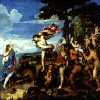COMMISSIONING:
Commissioned for the Camerino d’Alabastro in the Ferrara Castle. One of a series ordered by Alfonso d’Este, Duke of Ferrara.
COMPLETED:
1523
SUBJECT-MATTER:
The subject of "Bacchus and Ariadne" is a mythological story from the classical authors: Ovid and Catullus.
Ariadne, the daughter of King Minos of Crete, was rescued from the labyrinth by her lover, Theseus, who then abandoned her on the Greek island of Naxos.
Bacchus, the Greek god of wine, met Ariadne, fell in love with her, and turned her into a constellation.
The painting also includes other mythology by the inclusion of the Laocoon, the Trojan priest who, with his 2 sons, was crushed to death by snakes for warning the Trojans against the wooden horse.
COMPOSITION:
The thought that Titian put into the complex composition of this painting is one of the most impressive features of many. Casual observers often see the painting as a rich mix of colour and subject-matter but often fail to note the many different compositional techniques used to make the painting so pleasing to the eye and that also emphasise and contrast key areas.
The first technique is the splitting of the painting into 2 halves by an imaginary diagonal from the top-right of the painting to the bottom-left, making the upper left awash with the rich blues of the sky and Ariadne's clothing and the lower right deep with browns and greens of the revellers, trees and vegetation.
The second technique is the use of horizontals to demarcate the
painting as well as emphasise the main characters. The first horizontal
is the horizon that joins the shoulder of Ariadne with the first female
reveller giving the characters balance and further strengthening the
link of the 2 females who are each facing each other. This horizontal
goes on to connect with
the head of the Laocoon giving that character added visual
significance.
The second horizontal is the white cloud formation above the horizon
that connects with Bacchus's head and goes on to connect with the
upheld arms of 3 revellers. This physically, and metaphorically, places
the 2 main characters on different levels and also completes the
classic "pyramid" technique of placing a triumvirate of characters in a
pyramid formation - the 3 points of the pyramid here being: Bacchus,
Ariadne and the Laocoon.
The third horizontal is the higher white cloud formation that completes
the "rule of thirds" objective of splitting the painting into 3
(disproportionate) thirds.
There are a plethora of other less significant horizontals to give the
painting balance including Bacchus's right arm, the dog in the
foreground and the Laocoon's feet.
The third technique is the use of verticals, again to further
demarcate the painting as well as emphasise the main characters. The
first significant vertical is Ariadne herself who is stood upright and
leads the eye up to the constellation of stars that she was turned into
by Bacchus.
The second important vertical is Bacchus's leg creating a cross-hair
centrepoint with the horizon.
The third vertical is the largest of the trees that also joins the
horizon at the Laocoon's head thus emphasising that key character.
There are several other verticals of less significance including the
leading female reveller's leg and the other trees.
The fourth compositional technique is the dynamics of the characters, both independently, and in relation to each other. The revellers are particularly dynamic with Titian effectively creating the illusion of movement and order within the drunken procession. The revellers (including fat and drunken Silenus, Bacchus's ubiquitous companion) enter the scene from the right with the outer characters each facing the next one; this progressively carrying the viewer's eye easily from one to the other and on ultimately to Bacchus and then Ariadne who brings the view back into the painting itself by her facing into the centre, her twisting movement mirroring Bacchus's and turning towards Theseus whose departing boat can be seen in the distance. Bacchus gains added dynamism by being the only character from the brown/green lower-half of the painting to invade the blue upper-half of Ariadne's region, again emphasising the character's objective.

